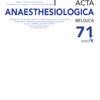Continuous Posterior Transversus Abdominis Plane (TAP) block in the management of chronic postsurgical pain of the abdominal wall
locoregional analgesia ; transversus abdominis plane block ; chronic postsurgical pain ; abdominal ; inflammatory bowel disease
Published online: Mar 30 2020
Abstract
We present the case of a 30-year-old man who developed chronic postsurgical pain (CPSP) after coloproctectomy with terminal ileostomy for severe inflammatory bowel disease refractory to medical treatments. CPSP was severe with negative impact on his quality of life and resistant to high doses of tramadol combined with antidepressants and benzodiazepine. Referred to our pain clinic he was first treated with repeated transversus abdominis plane (TAP) blocks which provided short-lasting pain relief. Because of the temporary effect of the infiltrations a catheter was then indwelled in the TAP under ultrasound guidance and local anesthetic was continuously infused for 10-days. Complete analgesia was reported during the infusion and persisted after removal of the catheter. Twelve months later, pain has markedly decreased, is reported as bearable and amenable with low doses of analgesics. A continuous TAP infusion was repeated twice separated by approximately one year. Thereafter no further infiltration was necessary.
